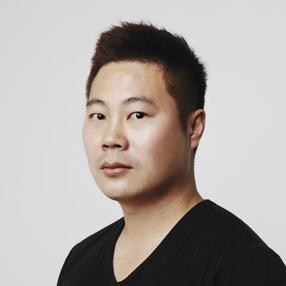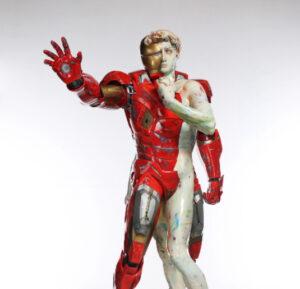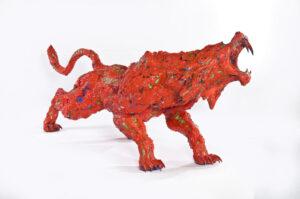






Ji Yongho graduated from Hongik University’s Department of Sculpture (2005) and obtained a Master’s degree in Fine Art from New York University Graduate School (2008). He made his debut on the art scene using unfamiliar material, tires.
With the concept of ‘mutants’, he tried to express the reality in which the truth has been distorted by fundamental human selfishness or desire, such as genetic engineering and environmental pollution.
Currently, he is producing ‘Hybrid Mutants’ and ‘Color Mutants’ series by overcoming the physical limitations of sculpture through 3D modeling techniques. Through these series, he can overcome the limitations of the ‘Tire Mutant’ series and enable him to express his thoughts.
- Works for Sale
- Artistic Career
- World of Work
- Activity
'Mutant' Series
'Mutant' Series
Solo Exhibitions (Brief)
In 2007, Ji Yongho held his first solo exhibition 《Mutant》 at Insa Art Space (Seoul, Korea). After that, he held his solo exhibition 《Mutant Mythos》 in 2009 at Gana Art Center (New York, USA). Through this exhibition, his name began to be known in the overseas art world. In this exhibition, exhibited representative works Jaguar 3 and Shark 6.
In 2013, the hammerhead shark series was exhibited at a booth at the F1 Stadium in Abu Dhabi, UAE. For.Smilodon, a hybrid of two smilodons, was exhibited at 《Anti-Art Museum Show: Against》 (K Contemporary Art Museum, Seoul, Korea, 2017). This work is installed by connecting the upper body of two Smilodon to a pole in the exhibition hall.
A new concept series was presented at the 《New Mutant》 (Gana Art Center, Seoul, Korea) exhibition in 2020. This series is characterized by the use of 3D printing techniques. There are two series, ‘Hybrid Mutants’ combined with objects, and ‘Color Mutants’ with colors.
Group Exhibitions (Brief)
The artist returned to Korea from New York in 2009 and participated in the exhibition 《Dissonant Visions》 held at the Seoul Museum of Art. It was an exhibition with the theme of creatures newly reinterpreted and born in the imagination of the artists or monsters with bizarre shapes.
The exhibition 《Korean Eye: Fantastic Ordinary》 held in 2010 at Saatchi Gallery (London, UK) is an exhibition designed to introduce Korean artists abroad. Companies were paying attention to the potential of young Korean artists and selected promising Korean artists on the international stage, and Ji Yongho was also selected to participate in the exhibition.
In addition, 《Power of Making》 (2011, Victoria & Albert Museum, London, UK), 《Let’s dance animal》 (2016, Chimei Museum, Taiwan), 《Outdoor Exhibition》 (2018, Suwon I’Park Museum of Art, Suwon, Korea), etc. Participated in several group exhibitions held at home and abroad.
Awards (Selected)
The artist won the Excellence Award at the ‘JOONGANG FINE ARTS PRIZE’ in 2003 and the 19th ‘Today’s Young Artist Award’ in 2011. ‘Today’s Young Artist Award’ is given to promote morale and inspire and promote creativity by rewarding cultural artists who have contributed to the development of culture and art.
Collections (Selected)
The International Contemporary Art Foundation, 21C Museum Hotel (Bentonville, USA), West Collection (Oaks, Pennsylvania, USA), National Museum of Modern and Contemporary Art (Seoul, Korea), Seoul Museum of Art (Seoul, Korea), Daejeon Museum of Art (Daejeon, Korea), Osan Museum of Art (Osan, Korea), Gana Art Park (Jangheung, Korea), Golf Zone (Daejeon, Korea) and other domestic and foreign collections have been.
'Mutant' Series
'Mutant' Series
Originality & Identity
Ji Yongho deals with new material, ‘tire,’ reflecting a contemporary uniqueness as a sculpture artist. The waste tire has a rigid texture, so it is easy to handle the materials and transform them in the artist’s intended way.
The artist understands that waste tire is a time-reflected artifact for an industrialized society and the material feature itself appears as a suitable object. Ji Yongho focuses on the semantic properties of tires that contain strong vitality, such as tension, speed, and strength. He discovers the possibilities of constructing his own sculpture with this reusable material rather than traditional materials.
“I would like to go to the highest level achieved by the masters using tires as a material.
Also, I am looking forward to exploring my own subject matter, expression method,
and the spirit of the present era (Zeitgeist) did not exist yet.”
The work that Ji Yongho wants to talk about with the original material he discovered is the truth distorted by human selfishness or desire and the world’s appearance. It sheds light on the side-effects of scientific development and ambivalence of human beings and the real problems of our time. It shows how we are dominated by mutants such as lies, hatred, and wrong power.
In this context, the series ‘Mutant’ (2003~) that Ji Yongho has been progressing is the creation of living things. Also, those do not exist in reality by distorting, hybridizing, or crossover from living creatures. The artist has made the artwork with waste tires for over 10 years, and he starts the new series ‘New Mutant’. He mentions that the new series is a hybrid concept compared to the prior one, which has a limitation of materials and outskirt shifts.
The new series is much more in-depth work in re-exploring the materials, colors, and textures. Ji Yongho says that sculpture contains all the essential elements of art. In this sense, Ji Yongho’s recent works have sincerity, exploring the essence of his art world.
Style & Contents
‘Tire Mutant’ is created with worn-out rubber tires, cut and pasted on a prefabricated frame with iron or wood to finish the sculpture shape. After the process, they build up a casting model.
The early work of this series uses only iron frame or casting modelling, but to express organic description, the artist finds out the solution from the conventional sculpture in the end. The tire texture, for skin expression, is also adopted by its form, part, muscles shape, feeling, and strength through its surface, elasticity, texture, width, and thickness.
He creates new mutated creatures, like animal figures, e.g. carnivores, herbivores, omnivores, and arthropods, depending on the corresponding intentions. In the series ‘Mutant’, the figures have a volumized sculpture by exaggerating each particle like jaguar legs.
Afterward, Ji Yongho tries to combine heterogeneous species in the ‘Hybrid Animal’ series, illustrating mythical and existing animals. The combination of the creatures evolved into a ‘hybrid human,’ a mixture of animals and humans.
In the artist’s recent series, he deals with more diverse materials and concepts, such as mutants between gods, which seems like a masterpiece of Rodin or mutants between Marvel characters.
Constancy & Continuity
In 2020, Ji Yongho started to pursue many organic works besides his materials, technology, and concept. The artist’s desire for a paradigm shift in the art world has been revealed before.
Ji Yongho said, “I’d like to sculpt a painting.” Likewise, he also announced the ‘Painting Series(Paint Sculpture)’, in which oil painting material was applied to the sculpture. The usage of oil painting and various colour paintings revoke his fluent art senses, influencing the artwork ‘New Mutant’.
The artist thought about the concepts of the ‘Mutant’ series, which he had been working on for nearly 20 years. Ji Yongho started ‘New Mutant’ to talk about his art in a conceptual way as contemporary art. The scope of references applied as the source is directly shown by using materials and forms, such as bronze, aluminum, and resin.
Ji Yongho has made various attempts to reflect and express a contemporary style originating from the sculpture. Finally, he enlarges his artistic identity by thinking fluidly about sculpting.
The favorable assessment of his recent works could also be seen in the art market. His entry works at his solo exhibition 《Mutant Color》(Soka Performing Art Center, Taipei, Taiwan) were sold out, an exhibition held in F1 Stadium (2013, Abu Dhabi, Arab Emirates) collected a large audience, and his recent performance at many other domestic and international art fair.
Also, Ji Yongho recently raised the question again, ‘what is sculpting?’ to revise his recent works. It is the right time for the artist to show his continuous artistic performance.
'Mutant' Series
'Mutant' Series
'Mutant' Series
'Mutant' Series
- Works for Sale
- Artistic Career
- World of Work
- Activity
'Mutant' Series
'Mutant' Series
Solo Exhibitions (Brief)
In 2007, Ji Yongho held his first solo exhibition 《Mutant》 at Insa Art Space (Seoul, Korea). After that, he held his solo exhibition 《Mutant Mythos》 in 2009 at Gana Art Center (New York, USA). Through this exhibition, his name began to be known in the overseas art world. In this exhibition, exhibited representative works Jaguar 3 and Shark 6.
In 2013, the hammerhead shark series was exhibited at a booth at the F1 Stadium in Abu Dhabi, UAE. For.Smilodon, a hybrid of two smilodons, was exhibited at 《Anti-Art Museum Show: Against》 (K Contemporary Art Museum, Seoul, Korea, 2017). This work is installed by connecting the upper body of two Smilodon to a pole in the exhibition hall.
A new concept series was presented at the 《New Mutant》 (Gana Art Center, Seoul, Korea) exhibition in 2020. This series is characterized by the use of 3D printing techniques. There are two series, ‘Hybrid Mutants’ combined with objects, and ‘Color Mutants’ with colors.
Group Exhibitions (Brief)
The artist returned to Korea from New York in 2009 and participated in the exhibition 《Dissonant Visions》 held at the Seoul Museum of Art. It was an exhibition with the theme of creatures newly reinterpreted and born in the imagination of the artists or monsters with bizarre shapes.
The exhibition 《Korean Eye: Fantastic Ordinary》 held in 2010 at Saatchi Gallery (London, UK) is an exhibition designed to introduce Korean artists abroad. Companies were paying attention to the potential of young Korean artists and selected promising Korean artists on the international stage, and Ji Yongho was also selected to participate in the exhibition.
In addition, 《Power of Making》 (2011, Victoria & Albert Museum, London, UK), 《Let’s dance animal》 (2016, Chimei Museum, Taiwan), 《Outdoor Exhibition》 (2018, Suwon I’Park Museum of Art, Suwon, Korea), etc. Participated in several group exhibitions held at home and abroad.
Awards (Selected)
The artist won the Excellence Award at the ‘JOONGANG FINE ARTS PRIZE’ in 2003 and the 19th ‘Today’s Young Artist Award’ in 2011. ‘Today’s Young Artist Award’ is given to promote morale and inspire and promote creativity by rewarding cultural artists who have contributed to the development of culture and art.
Collections (Selected)
The International Contemporary Art Foundation, 21C Museum Hotel (Bentonville, USA), West Collection (Oaks, Pennsylvania, USA), National Museum of Modern and Contemporary Art (Seoul, Korea), Seoul Museum of Art (Seoul, Korea), Daejeon Museum of Art (Daejeon, Korea), Osan Museum of Art (Osan, Korea), Gana Art Park (Jangheung, Korea), Golf Zone (Daejeon, Korea) and other domestic and foreign collections have been.
'Mutant' Series
'Mutant' Series
Originality & Identity
Ji Yongho deals with new material, ‘tire,’ reflecting a contemporary uniqueness as a sculpture artist. The waste tire has a rigid texture, so it is easy to handle the materials and transform them in the artist’s intended way.
The artist understands that waste tire is a time-reflected artifact for an industrialized society and the material feature itself appears as a suitable object. Ji Yongho focuses on the semantic properties of tires that contain strong vitality, such as tension, speed, and strength. He discovers the possibilities of constructing his own sculpture with this reusable material rather than traditional materials.
“I would like to go to the highest level achieved by the masters using tires as a material.
Also, I am looking forward to exploring my own subject matter, expression method,
and the spirit of the present era (Zeitgeist) did not exist yet.”
The work that Ji Yongho wants to talk about with the original material he discovered is the truth distorted by human selfishness or desire and the world’s appearance. It sheds light on the side-effects of scientific development and ambivalence of human beings and the real problems of our time. It shows how we are dominated by mutants such as lies, hatred, and wrong power.
In this context, the series ‘Mutant’ (2003~) that Ji Yongho has been progressing is the creation of living things. Also, those do not exist in reality by distorting, hybridizing, or crossover from living creatures. The artist has made the artwork with waste tires for over 10 years, and he starts the new series ‘New Mutant’. He mentions that the new series is a hybrid concept compared to the prior one, which has a limitation of materials and outskirt shifts.
The new series is much more in-depth work in re-exploring the materials, colors, and textures. Ji Yongho says that sculpture contains all the essential elements of art. In this sense, Ji Yongho’s recent works have sincerity, exploring the essence of his art world.
Style & Contents
‘Tire Mutant’ is created with worn-out rubber tires, cut and pasted on a prefabricated frame with iron or wood to finish the sculpture shape. After the process, they build up a casting model.
The early work of this series uses only iron frame or casting modelling, but to express organic description, the artist finds out the solution from the conventional sculpture in the end. The tire texture, for skin expression, is also adopted by its form, part, muscles shape, feeling, and strength through its surface, elasticity, texture, width, and thickness.
He creates new mutated creatures, like animal figures, e.g. carnivores, herbivores, omnivores, and arthropods, depending on the corresponding intentions. In the series ‘Mutant’, the figures have a volumized sculpture by exaggerating each particle like jaguar legs.
Afterward, Ji Yongho tries to combine heterogeneous species in the ‘Hybrid Animal’ series, illustrating mythical and existing animals. The combination of the creatures evolved into a ‘hybrid human,’ a mixture of animals and humans.
In the artist’s recent series, he deals with more diverse materials and concepts, such as mutants between gods, which seems like a masterpiece of Rodin or mutants between Marvel characters.
Constancy & Continuity
In 2020, Ji Yongho started to pursue many organic works besides his materials, technology, and concept. The artist’s desire for a paradigm shift in the art world has been revealed before.
Ji Yongho said, “I’d like to sculpt a painting.” Likewise, he also announced the ‘Painting Series(Paint Sculpture)’, in which oil painting material was applied to the sculpture. The usage of oil painting and various colour paintings revoke his fluent art senses, influencing the artwork ‘New Mutant’.
The artist thought about the concepts of the ‘Mutant’ series, which he had been working on for nearly 20 years. Ji Yongho started ‘New Mutant’ to talk about his art in a conceptual way as contemporary art. The scope of references applied as the source is directly shown by using materials and forms, such as bronze, aluminum, and resin.
Ji Yongho has made various attempts to reflect and express a contemporary style originating from the sculpture. Finally, he enlarges his artistic identity by thinking fluidly about sculpting.
The favorable assessment of his recent works could also be seen in the art market. His entry works at his solo exhibition 《Mutant Color》(Soka Performing Art Center, Taipei, Taiwan) were sold out, an exhibition held in F1 Stadium (2013, Abu Dhabi, Arab Emirates) collected a large audience, and his recent performance at many other domestic and international art fair.
Also, Ji Yongho recently raised the question again, ‘what is sculpting?’ to revise his recent works. It is the right time for the artist to show his continuous artistic performance.





